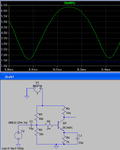sam_s.pitt
Newbie level 4
I want to design a single stage common emitter amplifier. I have read a manual about this. It recommends to choose Vcc=3Vce in a self bias configuration. (Vcc=bias source). I know that in order to have the maximum swing in output, the Q-point must be in the middle of the ac load line, which means that Vce=Vcc/2. can anyone describe this contradiction to me?
Moreover, I would be thankful if anyone introduce me a good book or manual on designing bjt amplifiers.
Moreover, I would be thankful if anyone introduce me a good book or manual on designing bjt amplifiers.

